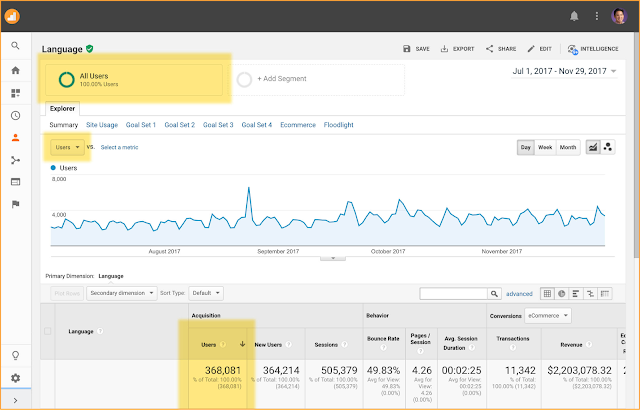Q&A with Econsultancy’s Stefan Tornquist and Google’s Casey Carey
“How can I put data at the center of my organization’s marketing strategy? Which teams need access to that data? And how should I train them to use it successfully?”
On Nov. 15, we hosted a webinar with Econsultancy to answer questions like these and discuss our recent
joint survey of over 700 marketing leaders about how they’re using data to stay ahead in their fields.
Casey Carey, Director of Platforms Marketing at Google, and
Stefan Tornquist, Vice President of Research at Econsultancy, walked through the results, revealing some fascinating takeaways.
Topics included everything from key skills and training to best practices in data-driven decision-making. One standout lesson? Teams across companies are focused on tying their data and analytics to business outcomes.
After the talk, listeners shared a number of follow-up questions for Casey and Stefan. Below, we’ve rounded up some of the most intriguing answers. Interested in the bigger picture? Check out the full webinar here:
7 ways marketing leaders use data to deliver better customer experiences.
1. What are the first steps marketing teams should take when they begin using multi-touch or data-driven attribution?Casey: First and foremost, attribution is a big data problem. Going into an attribution project, job one is to get your data house in order. Connect all your campaigns, prospective customer touchpoints, and conversion events; start establishing a taxonomy for naming channels, placements, sites, and so on.
Second, you have to reckon with the real organizational and cultural impacts of moving to an attribution model. Companies tend to be organized in channel silos. So when you begin looking at performance across channels to find the optimal mix, you have to break down those barriers.
Your executive leadership has to sponsor that, and your teams have to be willing to make the necessary changes.
2. What types of training typically help people in marketing get over the “I’m not an analyst, that’s not my job” attitude and use more data?Stefan: Many companies see training as either a technical discipline or an employee benefit, and one that comes at a cost. But with marketing becoming more sophisticated and technical, you need an ongoing training program for marketers that includes a foundation in statistics and in analytical practices and thinking, as well as core finance and business knowledge. You also need to provide training on the technologies themselves.
In our own research, we’ve seen that when they’re given the right training, marketers become more effective, stay in the organization longer, and are more likely to be promoted.
(
For more on training to use data, check out How to make everyone on your team a data-savvy marketer.)
3. What are some of the critical skill sets needed to lead this type of transformation and generate buy-in?Stefan: There’s a close association between marketing and analytics on the one hand and the business outcomes on the other. Leaders of a targeted transformation to data-driven marketing need to understand – and show that they understand – the business’s larger goals and issues. They need to connect abstract principles of analytics to practical outcomes and business KPIs – to close the gap between data and insights. They need to show how practical insights have actually been data-driven, how data gets you real answers that contribute to the business.
4. How can vendors and consultants help companies get the right resources and institute the organizational changes that are needed for success?Casey: Sometimes a vendor’s goal when they make a sale is to minimize the impact that their technology will have on resources and organizational structures. Companies buying a technology solution have to see that solution as part of an entire process and strategy, and ask vendors to help with that.
I always love when I’m talking to prospective clients and they ask questions such as: “OK, so, how does this impact my org structure? How many people and what skills do I need to actually be successful doing this? What other services should I be considering?” It really instills confidence that they’re actually going to realize the business value from the investment.
5. How do you cast a wider net from a data and analytics standpoint and ensure KPIs don’t miss critical trends and changes?Stefan: There’s got to be a balance. The insights we provide need to go beyond things like tweaks to make emails perform better. Instead, we need to think both analytically and creatively and ask higher-level questions. Things like, “What are our customers going to be doing in five years that’s going to make our current business model obsolete?”
Casey: You have to build into your organization the discipline to open your field of view so you’re not getting caught by surprise. Sometimes we get so focused on executing and optimizing towards KPIs and we lose that bigger view.
6. Do businesses get hung up on language when it comes to change? Is the word “marketing” sufficient to describe the scope of modern marketing? Stefan: Perhaps “marketing” isn’t sufficient to describe what modern marketing is becoming. Similarly, we say “digital marketing” even though digital is almost a vestigial word in this context – is there any aspect of marketing today that doesn’t have a digital component?
But the reality is we’re not going to change what we call things. What organizations can do internally is to change the “language-first” perception. To a certain degree, putting new terminology around it – “marketing-led transformation,” for example – does change how other stakeholders perceive it. But the bottom line is that marketing owns that customer relationship and owns that evolving customer knowledge. As such, it’s still going to be the core of whatever change is happening.
To see the slides and hear Stefan and Casey’s presentation, including the full set of Q&As,
download the webinar.
Posted by Matt Earp, Content Marketing Strategist, Google Analytics team










